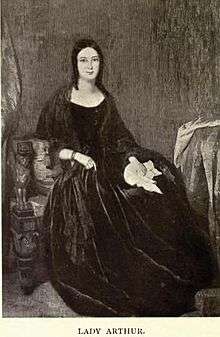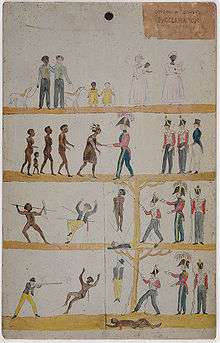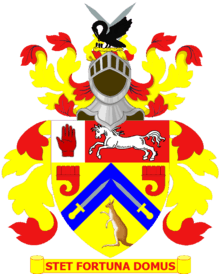Sir George Arthur, 1st Baronet
Sir George Arthur, 1st Baronet KCH (21 June 1784 – 19 September 1854) was Lieutenant Governor of British Honduras from 1814 to 1822, Van Diemen's Land (present-day Tasmania) from 1823 to 1837. The campaign against Aboriginal Tasmanians, known as the Black War, occurred during this term of office. He later served as Lieutenant Governor of Upper Canada from 1838 to 1841, and Governor of Bombay from 1842 to 1846.
Sir George Arthur, Bt. KCH | |
|---|---|
.jpg) | |
| Superintendent of British Honduras | |
| In office 1814–1822 | |
| Preceded by | John Nugent Smyth |
| Succeeded by | Allan Hampden Pye |
| Lieutenant Governor of Van Diemen's Land | |
| In office 14 May 1824 – 29 October 1836 | |
| Preceded by | William Sorell |
| Succeeded by | Sir John Franklin |
| Lieutenant Governor of Upper Canada | |
| In office 1838–1839 | |
| Preceded by | Sir Francis Bond |
| Succeeded by | The Lord Sydenham |
| Governor of Bombay | |
| In office 9 June 1842 – 6 August 1846 | |
| Preceded by | Sir James Rivett-Carnac |
| Succeeded by | Lestock Robert Reid |
| Personal details | |
| Born | 21 June 1784 Plymouth, Devon, England |
| Died | 19 September 1854 (aged 70) London, Middlesex, England |
| Spouse(s) | Eliza Orde Usher Smith |
Early life
George Arthur was born in Plymouth, England. He was the youngest son of John Arthur, from a Cornish family,[1] and his wife, Catherine, daughter of Thomas Cornish. He entered the army in 1804 as an ensign and was promoted lieutenant in June 1805. He served during the Napoleonic Wars, including Sir James Craig's expedition to Italy in 1806. In 1807 he went to Egypt, and was severely wounded in the attack upon Rosetta. He recuperated and was promoted to captain under Sir James Kempt in Sicily in 1808, and participated in the Walcheren expedition in 1809.
Family

Major George Arthur married Eliza Orde Ussher, daughter of Lieut.-Gen. Sir John Sigismund Smith, K.C.B., in May, 1814. Lady Arthur lived in Toronto, Ontario 1838–41 with three of the couple’s sons and their five daughters. She died in London, England, 14 January 1855. Their daughter Catherine married Sir Henry Bartle Frere after he had been her father's personal secretary for two years in Bombay, and gave birth to the poet Mary Frere.[2][3] Their son John married Aileen Spring Rice, the granddaughter of Lord Monteagle of Brandon.
Honduras
In 1814 he was appointed lieutenant governor of British Honduras, holding at the same time the rank of colonel on the staff, thus exercising the military command as well as the civil government. His dispatches about the suppression of a slave revolt in Honduras were seen by William Wilberforce and other philanthropists, and contributed in no slight degree to the 1834 abolition of slavery within the British Empire.
Van Diemen's Land

In 1823 he was appointed lieutenant governor of Van Diemen's Land (later known as Tasmania). He arrived on the ship Adrian with his wife and family on 12 May 1824 and took office on 14 May. At the time Van Diemen's Land was the main British penal colony and it was separated from New South Wales in 1825. It was during Arthur's time in office that Van Diemen's Land gained much of its notorious reputation as a harsh penal colony. He selected Port Arthur as the ideal location for a prison settlement, on a peninsula connected by a narrow, easily guarded isthmus, surrounded by shark-infested seas. Arthur's predecessors had executed no one in Tasmania (capital punishment was carried out in Sydney); he executed 260 in his term of office (some bodies were left hanging for months)[4]
He is also associated with the repression and persecution of the Aboriginal population in the conflict known as the Black War. Throughout the 1820s Arthur had instituted various measures to protect settlers from Aboriginal attacks, including the stationing of garrison troops in remote farmhouses and the dispatch of combined military and police teams into the wilderness to track indigenous bands.[5] These proved ineffective, and by 1830 the conflict between Aborigines and settlers had increased. In February 1830 Arthur sought public input on alternative measures to end the fighting; suggestions included a system of rewards for captured Aborigines, and the importation of packs of hunting dogs to "set [on] the natives as they would a quail." Arthur himself expressed regret that a treaty was not signed with Aborigines when the colony was established. In its absence, and given the increasing attacks on both side, on 27 August 1830 Arthur obtained Executive Council approval for a declaration of martial law.[5]
The centrepiece of Arthur's military efforts would be the Black Line fiasco, which was intended to drive the Aborigines from the colony's grazing land onto isolated peninsulas where they could be controlled. At the beginning of the Black War in 1826 Arthur issued an official statement setting out those situations that would justify settlers using violence: 'If it should be apparent that there is a determination on the part of one or more of the native tribes to attack, rob, or murder the white inhabitants generally, any person may arm, and joining themselves to the military, drive them by force to a safe distance, treating them as open enemies[6]
He failed in his attempts to reform the colony and the system of penal transportation with Arthur's autocratic and authoritarian rule leading to his recall in January 1836. By this time he was one of the wealthiest men in the colony. He departed Hobart for England on 30 October 1836.
Canada
In 1837 Arthur was knighted as a Knight Commander of the Royal Guelphic Order (KCH),[7] given the rank of Major General on the staff. In December 1837 he was appointed lieutenant governor of Upper Canada and took office in Toronto from 23 March 1838. From the very start of his administration, he had to deal with the aftermath of the Upper Canada Rebellion and was instrumental in the execution of Peter Matthews (rebel) and Samuel Lount. In the same year, Upper Canada was invaded by a band of American sympathizers, one of a series of attempts to subvert British authority in Upper and Lower Canada. He failed to address the issues of fixing colonial administration from the influence of Family Compact, and was replaced by Lord Durham while the 13th Parliament of Upper Canada sat betimes.
The two colonies were united in 1841. The Lord Sydenham, the first governor-general, asked Sir George Arthur to administer Upper Canada as deputy governor. Arthur agreed, on condition that the service was unpaid. Later in 1841 he returned to England and was created a hereditary baronet in recognition of his services in Canada.[8]
India
On 8 June 1842, he was appointed governor of the Indian presidency of Bombay, which he retained until 1846. He displayed great tact in the office, as well as ability, and this helped in extending and strengthening British rule in India.
He was appointed provisional governor-general, but did not assume office, as he was compelled by ill health to leave India before Lord Hardinge vacated the governor-generalship.
Sir George Arthur, during his administration of the affairs of the presidency, perfected the Deccan survey, the object of which was to equalise and decrease the pressure of the land assessment on the cultivators of the Deccan; and gave his hearty support to the project of a railway line from Bombay to Cailian, which may be regarded as the germ of the Great Indian Peninsular Railway, while during his administration the reclamation of the foreshore of the island of Bombay was projected. During his tenure, he inaugurated the famous 'Grant Medical College' in Bombay (1846 AD) one of the first three Medical Colleges in India teaching the western medical sciences. The other two being, the Medical College, Bengal (1835 AD) and Madras Medical College (Formerly Madras Medical School in 1835 and later, Madras Medical College in 1850 AD). The hospital for the Grant Medical College, the Jamshedji Jijiboy Hospital was constructed by the Parsee Trust beforehand.
Final years
On his return to England in 1846, he was made a privy councillor, and in 1853 he received the colonelcy of the 50th (Queen's Own) Regiment of Foot. He was promoted to lieutenant-general in 1854 and died that September.
 |
|
See also
- 1828 Proclamation of Demarcation
- Lieutenant Governor of Ontario
- Governor of Bombay
- Lieutenant Governor of Van Diemen's Land
References
- Shaw, A.G.L. "Arthur, Sir George (1784–1854)". Australian Dictionary of Biography (online ed.). Retrieved 6 October 2018.
- Morgan, Henry James, ed. (1903). Types of Canadian Women and of Women who are or have been Connected with Canada. Toronto: Williams Briggs. p. 14.
- Raza, Rosemary Cargill. "Frere, Mary Eliza Isabella [May] (1845–1911)". Oxford Dictionary of National Biography (online ed.). Oxford University Press. doi:10.1093/ref:odnb/33273. (Subscription or UK public library membership required.)
- Boyce, James (2008). Van Diemen's Land. Black Inc. p. 169. ISBN 9781863954136.
- Connor, John (2002). The Australian Frontier Wars 1788–1838. University of New South Wales Press. pp. 93–95. ISBN 0868407569.
- Reynolds, Henry (2013). The Forgotten War. UNSW Australia. p. 63. ISBN 9781742233925.
- "No. 19527". The London Gazette. 26 July 1837. p. 1978.
- "No. 19975". The London Gazette. 4 May 1841. p. 1138.
- Debrett's Peerage, Baronetage, Knightage & Titles of Courtesy. 1878.
- Serle, Percival (1949). "Arthur, George". Dictionary of Australian Biography. Sydney: Angus and Robertson.
Further reading
- Alexander, Alison, ed. (2005). The Companion to Tasmanian History. Hobart, Tasmania: Centre for Tasmanian Historical Studies, University of Tasmania. ISBN 1-86295-223-X. OCLC 61888464.
- Buckner, Phillip (1985). "Arthur, Sir George". In Halpenny, Francess G (ed.). Dictionary of Canadian Biography. VIII (1851–1860) (online ed.). University of Toronto Press.
- Robson, L. L. (1983). A History of Tasmania. Volume I. Van Diemen's Land From the Earliest Times to 1855. Melbourne: Oxford University Press. ISBN 0-19-554364-5.
- Shaw, A.G.L. "Arthur, Sir George, first baronet (1784–1854)". Oxford Dictionary of National Biography (online ed.). Oxford University Press. doi:10.1093/ref:odnb/707. (Subscription or UK public library membership required.)
External links
- Bio at Australian Dictionary of Biography
- World Statesmen – Belize
- "Archival material relating to Sir George Arthur, 1st Baronet". UK National Archives.

- The Procalamation Cup
| Government offices | ||
|---|---|---|
| Preceded by John Nugent Smyth |
Superintendent of British Honduras 1814–1822 |
Succeeded by A. H. Pye |
| Preceded by Colonel William Sorell |
Lieutenant Governor of Van Diemen's Land 1824–1836 |
Succeeded by Captain Sir John Franklin |
| Preceded by Sir Francis Bond Head |
Lieutenant Governor of Upper Canada 1838–1839 |
Succeeded by The Lord Sydenham |
| Preceded by James Rivett-Carnac |
Governor of Bombay 1842–1846 |
Succeeded by Lestock Robert Reid |
| Baronetage of the United Kingdom | ||
| Preceded by New Creation |
Baronet (of Upper Canada) 1841–1854 |
Succeeded by Frederick Arthur |
| Academic offices | ||
| Preceded by Sir Francis Bond Head |
Chancellor of King's College 1838–1841 |
Succeeded by The Lord Sydenham |